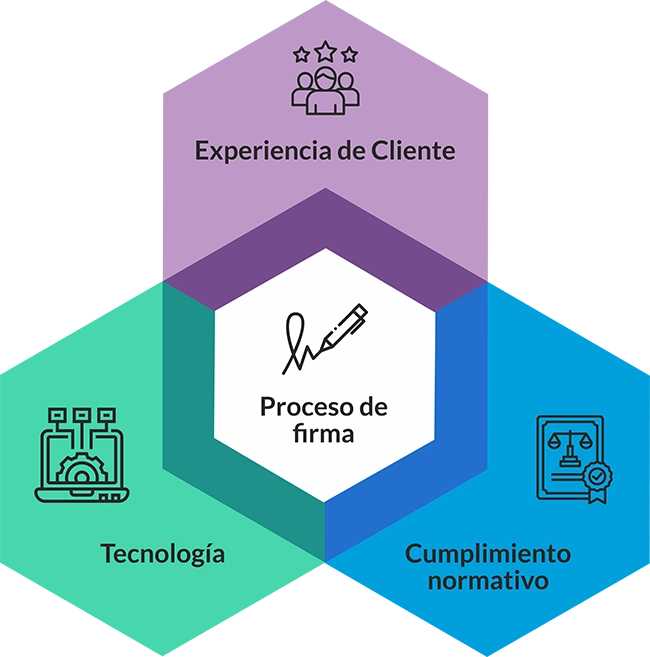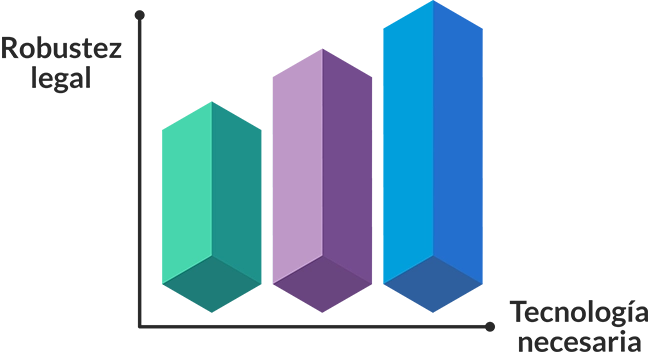Table of Contents
Find the balance
One of the biggest challenges in any e-signature process is getting as many people as possible – customers, employees or suppliers – to complete the process easily, quickly and securely. The secret? Finding the balance between three key factors: appropriate technology, good user experience and regulatory compliance.

1. Technology, your ally to prevent fraud (and much more).
In electronic signature processes, technology not only facilitates expertise and legal compliance: it is also your main barrier against fraud.
As the legal value of the document to be signed increases, so does the need to incorporate technologies that protect the signer’s identity and guarantee the integrity of the process. We are talking about tools that:
- They verify the signer’s identity: from an OTP code via SMS or email, to more robust systems such as digital certificates, biometrics or certified video identification.
- They ensure that the content has not been altered: through the use of time stamps, encrypted electronic signatures or secure storage.
- They leave a certified trace of the process: collecting evidence of who, when, how and from where it was signed, which not only has probative value, but also deters attempts at manipulation.
Each technology provides a layer of security and evidence. By orchestrating them correctly, you can design processes that are secure, efficient and proportionate to the risk level of the document or transaction. But remember: more technology can also mean more friction. That’s why balancing security and user experience is key.
2. Customer experience, the great differential factor
In the end, signing is an act of trust. And when this takes place in a digital environment, that trust must be built through a clear, secure experience adapted to the signer’s profile.
Some practical advice:
- Communicate through the most appropriate channel and at the right time: Does your signatory prefer WhatsApp, SMS, email or even paper?
- Act based on your customer’s behavior: There are solutions that allow you to launch multichannel processes and alternate channels based on user behavior. How would you like to receive a paper document that takes you through a QR to an electronic signature process just by using your cell phone?
- Adapt to the degree of digitalization of your audience: Although in all cases we must seek simplicity, we cannot and should not ignore this point.
- Eliminate barriers: Offer remote assistance, guided processes, automatic reminders and simple options to facilitate signing on the first attempt.
3. Regulatory compliance: yes, but with a good head
The legal framework regulating electronic signatures in Europe is the eIDAS Regulation, which classifies signatures into three levels: simple, advanced and qualified.
The higher the level, the more evidence it generates and the more legal value the signature has, but also the more complexity the process involves.
For example, a simple signature may be sufficient for an informed consent or acceptance of terms. In contrast, a qualified signature may be more appropriate for contracts with higher risk or legal implications. It’s not just a matter of “more security = better”, but of finding the right level of signature for each use case.
Raising the signature level involves incorporating additional technologies to validate identities, store evidence, and ensure the integrity of documents, which can translate into more steps and more friction for the signer. And we already know that every extra click can lower the signature rate.
We explain it in more detail in this entry, in case you want to learn more about eIDAS signature types.

In a nutshell
To increase signature rates in your digital processes:
- Get to know your signatory and adapt the process to his or her reality.
- Adjusts the level of legal security to the type of document or transaction.
- Lean on multichannel technologies that allow you to launch and redirect processes according to user behavior.
- Make it easy: a clear and frictionless experience can make the difference between a signed process and an abandoned one.

